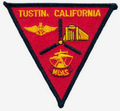Marine Corps Air Station Tustin facts for kids
Quick facts for kids Marine Corps Air Station Tustin |
|
|---|---|
| Tustin, California | |

Hangar No. 2 (Building 29) at the former Marine Corps Air Station in Tustin, California measures 1,072 feet (327 m) long by 292 feet (89 m) wide by 192 feet (59 m) tall. It and its "sister" structure (partially visible to the right) are listed on the National Register of Historic Places and designated a National Historic Civil Engineering Landmark. The two hangars, built in 1942 of Oregon Douglas fir, are among the largest freestanding wooden structures in the world. While its sister structure (the North Hangar) is slated to be included in a new park, the future of this hangar is uncertain.
|
|
| Type | Military base |
| Site information | |
| Controlled by | United States Marine Corps |
| Site history | |
| Built | commencing 1 April 1942 |
| In use | 7 October 1942 – 2 July 1999 |
Marine Corps Air Station Tustin (also known as MCAS Tustin) was a special airport for the United States Marine Corps in Tustin, California. It was once a very important place for military helicopters and airships. The base was known for its two giant wooden hangars, which are some of the largest wooden structures in the world.
Contents
A Look Back: The Story of MCAS Tustin
How it Started: Airships and World War II
The air station began in 1942. It was first called Naval Lighter-Than-Air Station Santa Ana. Its main job was to support the United States Navy during World War II. Large airships, like blimps, flew from here. They helped patrol the coast and look for enemy submarines.
The base officially opened on October 1, 1942. It had many officers, enlisted men, and civilian workers. In 1949, the airship base was closed down.
A New Role: Helicopters and Later Wars
In 1951, the base reopened. It was renamed Marine Corps Air Facility Santa Ana. This time, it became the country's first air facility built only for helicopter operations. This was important because helicopters were becoming very useful in wars.
During the Korean War, the base supported helicopter training. Later, during the Vietnam War, it was a key place for testing radar equipment. This equipment was then sent to South Vietnam. The base also trained many helicopter pilots for the war.
A Busy Base: Life at MCAS Tustin
By the early 1990s, MCAS Tustin was a major center for Marine Corps helicopters. It helped support the 3rd Marine Aircraft Wing and other military units. About 4,500 people lived on the base. Nearly 5,000 military and civilian staff worked there.
The base also rented out some of its land to farmers. This land was used to grow crops. For many years, farms surrounded the base. But in the 1980s, new homes and businesses started to grow up nearby.
Closing Down: A New Future for the Land
In the early 1990s, the government decided to close MCAS Tustin. This was part of a plan to reorganize military bases. The base officially closed in July 1999.
Today, much of the former base has been changed. About 1,294 acres are now called "Tustin Legacy". This area has new homes, businesses, schools, and parks. The remaining land will also be used for similar purposes after environmental clean-up is finished. The site is now home to the academy for the Orange County Sheriff's Department.
The Famous Hangars
The two giant blimp hangars at MCAS Tustin are very special. In 1993, they were named a National Civil Engineering Landmark. This means they are important examples of engineering. There have been talks about turning one of the hangars into a military museum.
One of the hangars is still used today. A company called Worldwide Aeros Corp used it to build a new type of cargo airship. This was a project for the Pentagon and NASA. Sadly, in 2013, part of the roof collapsed and damaged the airship.
What's Next: The Future of the Area
New Parks and Possibilities
Plans are being made to turn 84.5 acres of the former base into a large regional park. This park is expected to open in the future. Local groups are asking the community for ideas on what the park should include.
Even though many people want to save the hangars, the future of the south hangar is still uncertain.
Sports and Community
The City of Tustin has even talked with the Los Angeles Angels of Anaheim baseball team. They suggested the former air base as a possible site for a new baseball stadium.
In 2016, a deal was made to use ten acres of the land for a new animal shelter. This new shelter will replace an older one in nearby Orange. A groundbreaking ceremony for the new shelter was held in July 2016.








